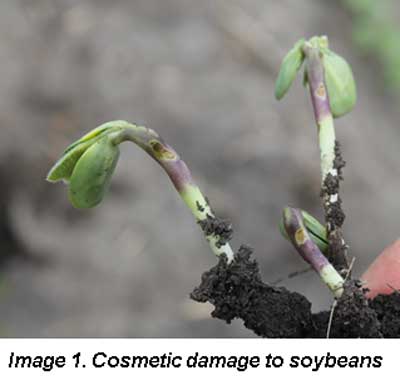
- Soybean injury from PRE herbicides is rare.
- Injury from seedling blights and pathogens can be difficult to distinguish from herbicide injury.
- Several factors contribute to risk for soybean injury, including the herbicide used and environmental conditions after planting.
- In most cases, injury is cosmetic and soybeans will recover.
Recently, we have received several inquiries about the possibility of herbicide injury to emerging soybeans. From past experiences, we know that under certain weather conditions, soybeans might be susceptible to phytotoxicity from preplant and PRE applications of PPO or triazine herbicides. Generally, the damage that results in these situations is cosmetic and has no influence on yield potential.
There are many factors that have to align to see any potential response from these herbicides. Weather is a key contributor in these situations. We are much more likely to see a response when wet weather is combined with extended periods of cool temperatures. In addition to the weather, soybeans generally need to have germinated with the hypocotyl pushing closer to the soil surface. When these factors come together at just the right time, we can see some crop response. Let's further dive into why this is possible.
Separation of the herbicide from the seed in the ground can play a major role in the safety of the soybeans crop. We usually plant soybeans 1" or greater in the soil. This means that when we apply herbicides PRE, there is a buffer between the herbicide and the seed. When the soybean germinates, it starts to move closer to the soil surface and closer the herbicide zone. If we get excessive moisture before the soybean emerges, it places much of the herbicides in soil solution and can potentially damage the seed. Excessive moisture alone typically does not cause this response, because the soybeans quickly grow through this herbicide solution without any issues. Pair excessive rainfall with a cold front, and the length of time it takes for the soybean to emerge increases dramatically. This means that the soybean is near the herbicide for a much greater time and injury could result.
Now that we know how it happens, what does it look like? Most of the time, we see minor necrotic tissue on the hypocotyl arch (Image 1). This type of damage is only cosmetic and there is little to worry about. The damage we would be concerned about would be hypocotyl girdling that limits nutrient movement and can result in stand loss (Image 2). In addition, the seed treatment ILeVO® can additively affect the injury; however, the very reason we use ILeVO® is to protect against sudden death syndrome which is caused by fusarium infecting the plant during the cool, wet conditions. The minor potential for ILeVO® to elevate crop response is offset by increased yield when sudden death strikes. Lastly when evaluating soybean, let's not forget that injury resulting from seedling blights and pathogens can look very similar to herbicide injury.
Final Thoughts: Every year there are concerns over crop response from some PRE herbicides, and this year is no different. Also, while we spent a large portion of this newsletter speaking about the damage from the herbicide, it really is a chain of events that causes the response and the herbicide is only one piece of the puzzle. Inquiries this year to date have been largely due to the emotional response that crop injury elicits; in most cases, the soybean will grow out of any damage that may have been caused. With the absence of significant stand reduction, do not make hasty decisions and give the soybeans a week to recover. You will be glad you did!
Contact your FS Crop Specialist for your agronomic information.
